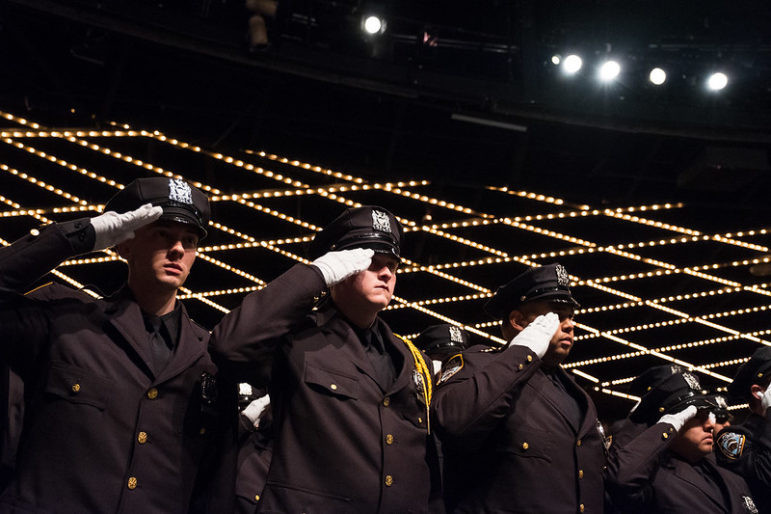
Edwin J. Torres/Mayoral Photography Office
A 2017 NYPD graduationAs New Yorkers live through the city’s most tumultuous and politically energizing period in recent history, the NYPD is desperately trying to snatch the status quo from the jaws of progress.
Something is different this time as advocates have already won a few hard-fought policy battles over the last several weeks including passage of the STAT Act and repeal of a police secrecy statute that prevented disclosure of officer personnel records. Protests have also led to the dissolution of the NYPD’s anti-crime units, made up of approximately 600 plainclothes officers who have been responsible for a disproportionate share of police shootings since 2000.
Unfortunately for the Defund and police accountability movements, the NYPD has a tried-and-true formula for quelling any criminal justice related-reforms they don’t like—scaring people into submission.
We saw it after the passage of the bail reform bill that has spared thousands of legally innocent Black and brown New Yorkers from languishing in jail on unaffordable bail, and we’re seeing it again as the NYPD feverishly tries to escape the movement of accountability surrounding them. The reality is the NYPD goes to great lengths crafting causation where there is none, misleading the public, and, yes, even lying to maintain the unmitigated, militaristic power they enjoy in the city.
This scheming has proven successful and recently led Gov. Andrew Cuomo to roll back the bail reforms in this year’s budget after a mere three months in effect. Compared to the original reforms, the rollback that went into effect on July 2 is projected to lead to a 16 percent relative increase in the number of people incarcerated while awaiting trial at a time when jails and prisons have become some of the worst hot spots in the country for COVID-19.
The NYPD—with a heavy assist from the media who abdicate their duty to present the news and instead behave as the NYPD’s press outlet—is utilizing the same tactics to kneecap the Defund movement and even “softer” accountability measures, like making chokeholds illegal and the disbanding of the anti-crime unit.
Just days after the notoriously lawless anti-crime unit was disbanded, police began linking that to an uptick in shootings without offering any proof. Now the rise in shootings is due to bail reform, COVID releases and the shuttering of the courts, which, ironically, actually means that people who are arrested for violent felonies are being detained indefinitely because of the suspension of due process.
But that doesn’t matter. Neither does the fact that police analysts who propagate a return to a high-crime era in New York fail to take into account the unique moment New York, and the world, is in. Millions of recently unemployed people have been cooped up in their homes, with some offered a scant $1200 in aid, and now many are facing evictions as a result of the COVID-19 pandemic. It is impossible to measure the impact this has had on crime because it is simply an unprecedented crisis. It is also simply true that shooting incidents always rise in warmer months.
Whether by highlighting an apparent increase in gun violence and predicting death and lawlessness or outright lying like the fabricated story of an attempted poisoning of officers at Shake Shack, the NYPD’s goal is to preserve the status quo—and the department’s bloated budget—by painting themselves the “thin blue line” standing between New York and anarchy. Despite the “something” that makes this moment ripe for real, lasting change, the NYPD’s grip is hard to shake, as we saw with last week’s City Council vote on a budget that fails to deliver a modicum of real change, signaling that New York City will not be free of them whether in schools or on the streets.
But something is different. And hopefully the Defund movement can achieve something the bail reform movement was unable to do—make it politically impossible for those elected in this city and this state to deliver anything less.
Marie Ndiaye is the supervising attorney in the Decarceration Project at The Legal Aid Society.









3 thoughts on “Opinion: Cops are Using Fear to Fight Reform”
I feel terribly for what our NYPD officers have gone through recently. They risk their lives everyday in the nation’s largest city to be ridiculed and harassed by hooligans. They have a mayor that enables this under the guise of equality. Mayor DeBlasio is a disgust and should be removed from office. DEFUND Mayor DeBlasio. DEFUND Capitol Hill. NYPD, know many people stand with you!! We want law and order back in our city!!!
“Law and order” is a euphemism for keep African-Americans in their place. It has been since at least the days of Nixon. Do you complain about the lack of law and order in the most corrupt presidential administration in history?
As seen in this article, there is currently a very heated debate occurring throughout the City on the future of the NYPD. I believe that one of the groups that should be listened to closely in this debate are the victims of crime. Per the 2019 NYPD crime statistics,
the majority of crime victims are African American American or Hispanic.
(See: https://www1.nyc.gov/assets/nypd/downloads/pdf/analysis_and_planning/year-end-2019-enforcement-report.pdf ). I hope that City Limits can find a way to make their voices heard in this ongoing debate which is crucial to the future of us all.